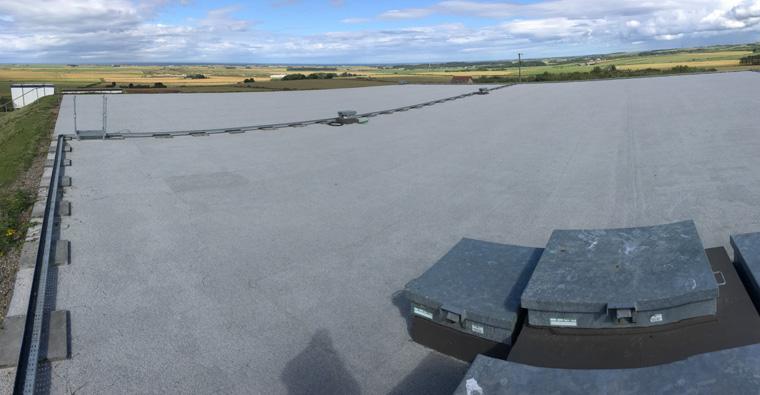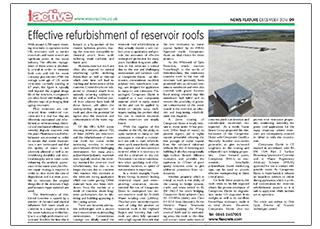In the December issue of Water Active, Chris Lloyd looks at water retaining structures and explores the best solutions for refurbishing reservoir roofs.
With around 6,700 water retaining structures in operation in the UK, structures such as service reservoirs and water towers are significant assets in the water industry. The effective management of these assets is absolutely crucial in order to minimise both cost and risk for water company practitioners. With the average asset age of UK water structures currently standing at 67 years, this figure is typically well beyond the original design life of the structure, so engineers are often faced with finding cost-effective ways of prolonging their ageing structures.
Most structures are constructed from reinforced concrete and it is vital that they are effectively maintained and refurbished, as environmental, chemical and mechanical influences can severely degrade concrete over the years. Maintenance and refurbishment are essential in order to ensure that water transmission is not interrupted and that the quality of water is not adversely affected, as well as re-establishing durability and structural integrity and in some cases, enhancing the aesthetic appearance of the water asset. An effective repair strategy is required in order to slow down the rate of degradation and it is even possible to reinstate the original design life of the structure if high performance repair materials are used.
The deterioration of reinforced concrete is caused by a number of chemical and physical influences. Soft water attack on concrete is a major problem in the water industry, as it effectively acts as a high performance solvent and dissolves the lime that is formed as a by-product of the cement hydration process, leaving the concrete susceptible to chemical attack from acids including weak carbonic and humic acid. However, reservoir roofs are often also exposed to natural weathering cycles including freeze-thaw as well as thermal which over time will lead to cracking and deterioration of the concrete. Covered roofs are subjected to chemical attack from naturally occurring sulphates in the soil, as well as fertiliser runoff from adjacent farm land. All these factors will affect the waterproofing properties of roofs and allow the potential for ingress into the reservoir and contamination of the water supply.
Of the UK’s 6,700 water retaining structures, almost 75% of them (4,940) are reservoirs and the refurbishment of reservoir roofs has come under increasing scrutiny in recent years because of their challenging environment. For many years, polyurethane/polyurea materials were typically used as the industry standard for reservoir roof refurbishment, but this is no longer the case due to concerns with reaction with moisture in the substrate during application which can cause gassing. Other materials have also been withdrawn from the market as a result of concerns about long-term performance, due to blistering and bubbling appearing in the coating system.
Cementitious Coating Technology
There are, however, alternative technologies with a proven track record of use in demanding environments. Cementitious coatings are ideally suited for reservoir roof refurbishment as they actually require a wet surface prior to application and provide the assurance of effective waterproof protection for many years. Excellent long-term adhesion to the substrate is critical due to the wet and challenging environment and materials such as Cemprotec Elastic – an elastomeric, cementitious modified, polymer rich, waterborne coating – are designed for application to damp or wet substrates. Pre-packaged, Cemprotec Elastic is supplied as a two component material which is easily mixed on-site and can be applied by brush or simple spray techniques, making the product ideal for use in remote locations where reservoirs are usually found. With the vagaries of the weather in the UK, the ability to apply materials to damp or wet substrates is critical as contractors are able to start refurbishment work immediately without the expense and inconvenience incurred when it is necessary to wait for a structure to dry out.
Downtime is a crucial consideration when specifying roof refurbishment materials, so speed of reinstatement is important. In a recent example, Fraser Bruce Group, Scotland’s leading structural repair and waterproofing contractor, recommended the use of Cemprotec Elastic to waterproof two service reservoir roofs for Scottish Water totalling over 2,000m2. They had prior successful experience of using this product on reservoir roofs in the Highland Region and knowing that such roofs are often fully saturated with a high vapour drive, felt that the low resistance to water vapour made Cemprotec Elastic an ideal choice for these projects.
At the Whitewell of Tyrie Reservoir, which services Fraserburgh in the north of Aberdeenshire, the reinforced concrete roofs to the two cell structure had previously been protected with an oil-based bituminous membrane and were also covered with gravel. Routine flood testing revealed that this membrane had failed and to remove the possibility of potential contamination of the water stored in the reservoir, an effective and long-lasting refurbishment was required. A 2mm coating of Cemprotec Elastic is totally resistant to water under 10 bar pressure (100m head of water) to prevent ingress, yet is highly vapour permeable allowing the free passage of water vapour from the saturated substrate without the risk of blistering and bubbling. It also has exceptionally high carbon dioxide diffusion resistance and provides the equivalent to 135mm of good quality concrete cover to give additional protection from carbonation.
Another property which is critical on roofs is the ability of the coating to bridge dynamic cracks and when tested to BS EN 1062-7 for crack bridging, Cemprotec Elastic achieves Class A5 >2500?m (static) and Class 4.1: 0.2-0.5mm (dynamic). At the Herricks Water Treatment Works supplying the Moray town of Keith and its surrounding areas, the roofs to the clear and contact water tanks were of concrete plank construction and considerable movement was expected. As a result, Fraser Bruce Group proposed the reinforcement of the Cemprotec Elastic with Cemprotec Geo80, a thermally bonded non-woven geotextile, to give increased toughness to the coating and enhanced crack bridging properties. Over formed joints, Cemprotec 2000-S, an elastomeric, breathable polyurethane based reinforcing tape, can be used to provide effective waterproofing in these critical areas.
On both these projects, the roofs were to be left exposed where the proven resistance of Cemprotec Elastic to degradation under UV exposure from sunlight, as well as its excellent freeze/thaw resistance, made it an ideal choice. However, Cemprotec Elastic also has proven root resistance properties, confirming suitability for green roof applications for the many situations where reservoirs are subsequently covered to blend in with the countryside. Cemprotec Elastic is CE marked in accordance with BS EN 1504 Part 2 Surface Protection Systems for Concrete and also has a water-based formulation. As a result, it releases no hazardous solvents or odour during application, which is a critical consideration for reservoir refurbishment projects as it is safe to apply even whilst facilities are in operation.
Contact Us To Find Out More About Our Services
To download the article, please click on the button below:


